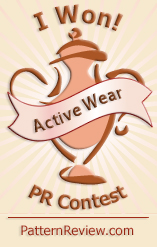In January (before broken wrist) I made another version of McCalls 7351 for my son's girlfriend. She had tried on my dress and loved it and I was so happy to make one for her. I had a few cotton print lengths in stash and offered them up. She chose a light and crisp cotton print.
 |
| What a busy print! Could benefit from a solid dark belt... |
Mulling it over I found a solution - when you need your fashion fabric to have a different hand, underline it for heaven's sake! I had lots and lots of this fabric. The upper portion of this dress is structured, as is the front band. My only concern was the skirt. So I cut it out twice.
 |
| Inside view of side & waist seams |
- Make bodice (yoke, collar etc) without sewing side seams.
- Sew right side (RS) skirt pieces to corresponding bodice pieces, RS together as usual.
- Sew wrong side (WS, underlining) skirt pieces to corresponding bodice pieces, RS skirt to WS bodice. Sew along stitching line established at step 2.
- Press skirt pieces down with waist seam allowances encased between the layers below the waist seam.
- Trim lower edge of WS skirt pieces to hem fold line.
- Baste corresponding skirt layers together (ensuring no rippling or unevenness), WS together, at side edges and CF. The WS skirt is shorter.
- Then treat skirt pieces as a single unit when constructing front band and side seams.
- Sew the hem as instructed in the pattern, but folding the RS skirt at hem line so it completely encases the WS skirt.
Mission accomplished. The dress awaits warmer weather and I hope it will be a comfy but stylish summer dress for the recipient.

At Christmas, I started another hand knitting project but its completion will now have to wait until after the cast is off. So far at least, hand knitting is completely unworkable with an immobilized wrist.
 |
| Upper back and collar Colour is pretty accurate |
This is an incredibly complex top down cardigan made in a fingering weight yarn. The pattern is Woodfords by Elizabeth Doherty. It has tons of short rows, tons of broken rib, and you dare not stop concentrating for even a minute while knitting. I got mixed up in counting and suddenly had the wrong size worth of stitches on my needle after doing the decreasing below the sleeve openings. I'm not too worried as this sort of yarn can be blocked to shape.
The pattern was designed for a yarn that seems to have qualities similar to Shetland yarn (not smooth or soft, woollen spun, lots of loft). I had a sweater quantity of yarn that I thought would work (vintage stuff in an amazing colour that is predominantly turquoise but has vivid purple aspects) and set to it.
 Aaaand I got down to about an inch into the "skirt" part of the pattern before abruptly having to stop. Now my timing is off for this to be finished in time to wear in late winter/early spring 2017.
Aaaand I got down to about an inch into the "skirt" part of the pattern before abruptly having to stop. Now my timing is off for this to be finished in time to wear in late winter/early spring 2017.
Stay tuned - I am pretty sure that knitting will be excellent physiotherapy once this blasted cast is gone.



I have just read this and the post before. So sorry to hear about your wrist! Must have felt soooo frustrating ..... I wonder how you could manage to make that perfectly matched printed top. My best wishes for your recovery!
ReplyDeleteGood idea with the fabric for the dress.
ReplyDeleteI am curious, why all the pins on the sweater? are they to mark your rows? if so, perhaps I need to be doing this too.
Yes, the pins are there to mark increase rows. Why buy fancy removable stitch markers when safety pins multiply in the drawer?
DeleteSo sorry to hear about your wrist! Really puts a cramp in your style. I hope it heals up quick for you. Does it come with a great story - like celebrities and the Alps?
ReplyDeleteLeigh